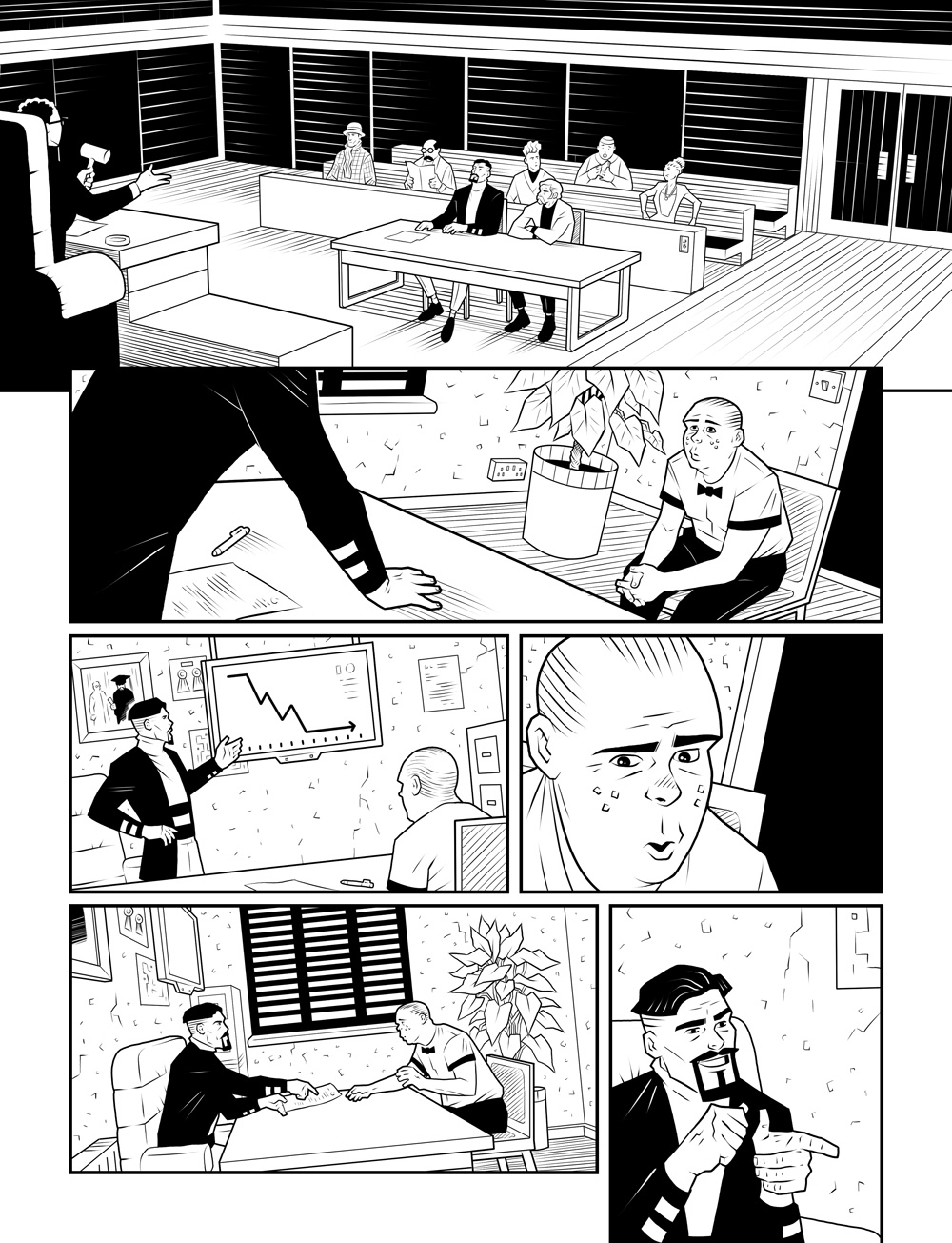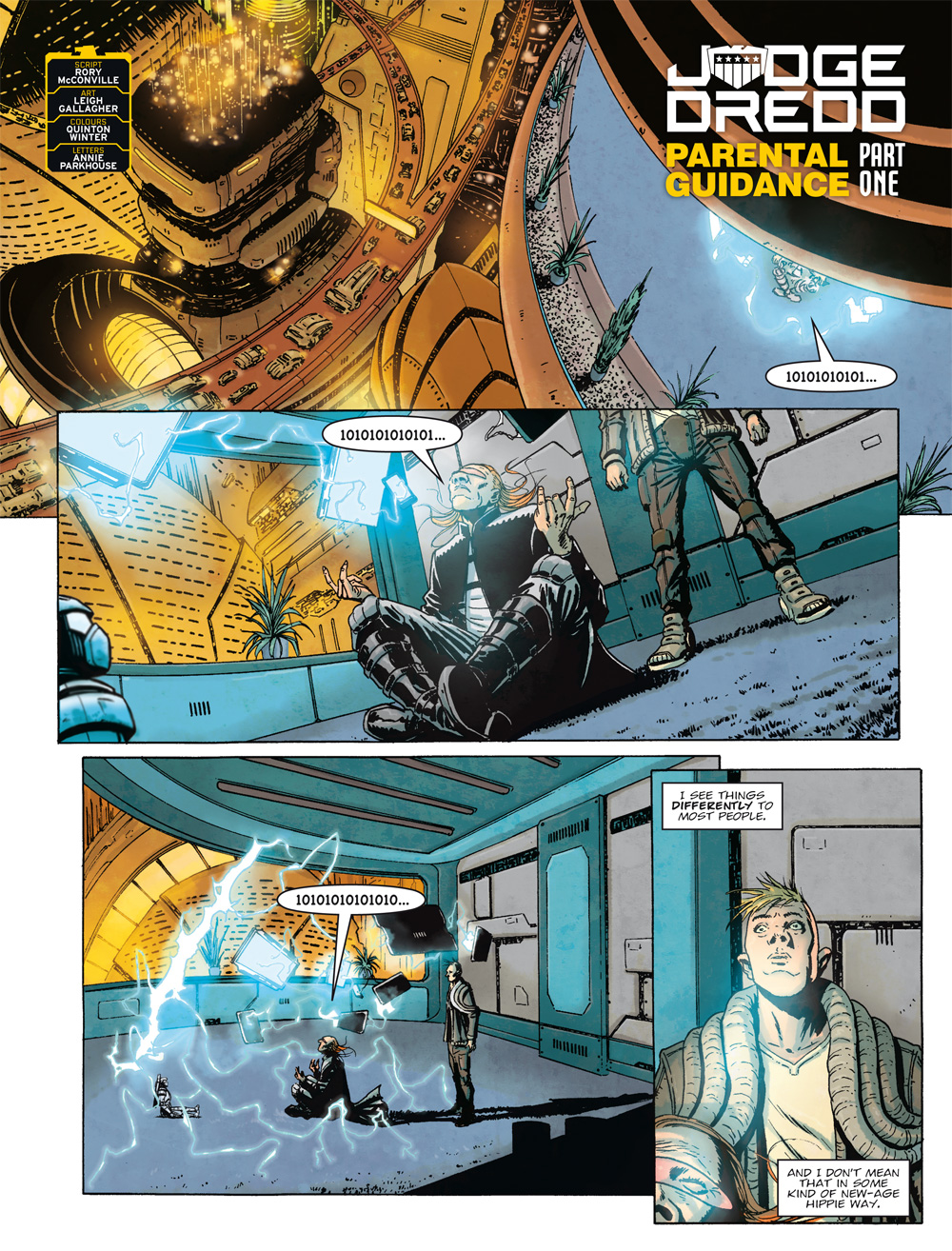The new droids who burst out of Thought Bubble: Rory McConville
19th September 2018
It’s Thought Bubble this weekend, with the two-day comic convention taking place 22-23 September across Leeds City Centre.
And, just as we have every year for many years, 2000 AD is running its new writer and artist talent search, a unique opportunity for new writers and artists to break into the house of Tharg.
Writers have the chance to pitch their idea for a Future Shock to a panel of 2000 AD superstars and a live audience, while artists get the opportunity to have a live art portfolio session.
Richard Bruton sat down with one of the most successful writers to have won the coveted prize, Rory McConville.
McConville won in 2015 with his pitch for Tharg’s Future Shock: Lifosuction that was published in Prog 1972 of 2000 AD, featuring art by the 2015 art portfolio winner, Joe Palmer.
Since then, McConville has been a regular in 2000 AD and the Judge Dredd Megazine, with strips including more Future Shocks, Tales From The Black Museum, Devlin Waugh, Cursed Earth Koburn, and he’s one of a new breed of writers on Judge Dredd.
Rory, going back to before your 2015 win of the 2000 AD writer search, how did you hear about it and what convinced you to enter?
Rory McConville: I saw it on the Thought Bubble website — I’d been aware that 2000 AD did a competition at Thought Bubble but I believe it had previously just been for artists. If a writer’s one had been around earlier, I would’ve definitely applied. It seemed to be the best avenue to get into 2000 AD.
What did the competition win and getting that first 2000 AD credit with your Future Shock mean for you?
RM: Winning it was hugely validating and felt like a lot of hard work had paid off. Future Shocks have such an iconic place in comics that it was a great thrill to be able to write one. I was really happy with how the story itself turned out too. Joe Palmer — who won the art competition that year — did a fantastic job on it.
As for the competition itself, can you tell us a little about the actual process of entering, the preparation involved and the terror of pitching in front of the judging panel of experts?
RM: Basically, you go in and pitch a Future Shock in under two minutes in front of an audience and a judging panel.
As far as my own preparation, I’d been working on a few potential ideas in the run up to the competition and had only settled on the Lifosuction one the Monday before Thought Bubble. In the week leading up to the competition, I practiced reading the pitch a lot, mainly to time myself and get a better feel of the rhythm. So there was a lot of editing and tweaking in the last few days.
As soon as the con opened, I showed up to the room of the competition because I thought it was going to be first come first served. Once we got in however, it turned out people were being picked at random, which was stressful – not actually getting to pitch would’ve been fairly crushing. Thankfully, I managed to get picked towards the end and once I was up there, the pitch itself went well – though I’m quite glad it wasn’t recorded!
Since winning the competition, your career at 2000 AD has really taken off. How important do you think the competition win was for that and how do you think your work has evolved since winning?
RM: I almost certainly wouldn’t be writing for 2000 AD if I hadn’t won it. I started working on more Future Shocks after the first one, then onto a Tharg’s 3riller, and then gradually worked up to several Dreddverse series, like Cursed Earth Koburn and Devlin Waugh, as well as Dredd himself. Working for 2000 AD has also been a great way of getting myself in touch with other publishers as well, so it’s had an enormous effect on my comics career. Writing Devlin has been one of my favourite jobs. John Smith and Sean Phillips created an absolute gem of a character.
Prior to 2000 AD, I’d been doing a fair bit of self-published stuff and contributing to small-press anthologies. I’d also produced two all-ages graphic novels focused on Irish history. One was Big Jim: Jim Larkin and the 1913 Lockout, which was illustrated by Paddy Lynch. The other, illustrated by Deirdre de Barra, was Brian Born and the Battle of Clontarf, focusing on the Battle of Clontarf in 1014.
As for how my work has evolved, being able to work across stories with vastly different lengths has given me a greater understanding of the form. Collaborating with artists of the calibre that 2000 AD attracts, as well as Tharg, has also been a huge boost for my work.
What advice would you give to up and coming writers and artists about getting into comics in general, and the 2000 AD/Thought Bubble competition in particular?
RM: My general advice to all creators would be to start small and make sure you get stuff finished. I self-published a lot of short comics early on to help me improve my storytelling.
I’d encourage anyone who wants a career in comics to go for the Thought Bubble competition. I know it’s terrifying but there’s no better opportunity than this, and if nothing else, it’s a great way of getting feedback. Practice as much as you can beforehand. I’d suggest reading your pitch aloud as much as you can to get comfortable with it, and also in front of people who’ll give you honest feedback.
In terms of story ideas, read over as many older Future Shocks as you can to make sure you’re not retreading old ground. Try to focus on an idea that’s action oriented and visually-engaging. Make sure your protagonist wants something. Avoid “virtual prison” twists at all costs!
There’s some great resources online and in print as well. Karl Stock did a great article in Judge Dredd Megazine #398 about writing Future Shocks and Alec Worley and Rob Williams both have great resources on their respective websites as well.
Finally, what’s coming up for you in the near, or not so near future?
RM: There’s a few Dredds on the horizon in the Prog and the Megazine. I’m working with some great artists like PJ Holden, Dan Cornwell, Clint Langley and Jake Lynch among others. I’m also doing a new Future Shock and a Tale From The Black Museum.




